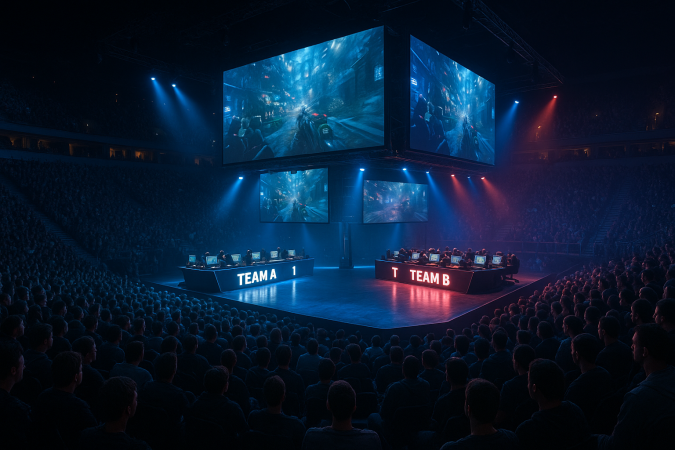Walk into an esports arena in 2025 and you feel it immediately—this isn’t a niche pastime anymore. These are full?scale, high?energy spectacles drawing thousands (and often tens of thousands) of fans to watch their favorite games unfold live. The pros and the titles will always command the spotlight, but more and more, the venues themselves are becoming part of the show.
They’re the places where iconic moments are made, and they’re starting to build the same kind of lore and legacy that traditional sports stadiums have had for decades.
The Growth of eSports
Before we spotlight the arenas and the events they host, a little context: the industry’s growth has been explosive—so much so that the biggest tournaments now require major venues to meet demand.
That boom extends to the broader ecosystem, too—especially wagering around events. Plenty of attendees aren’t just watching; many use mobile betting apps to track stats in real time and even place a bet on the matches everyone’s following.
Dong’an Lake Sports Park Multifunctional Gymnasium
The name might conjure a school gym, but don’t be fooled.
This is a modern, multi?purpose arena designed to host everything from traditional sports to top?tier esports.
For League of Legends fans, the World Championship is the crown jewel—and in 2025, the finals landed in Chengdu’s Dong’an Lake Sports Park Multifunctional Gymnasium. With room for about 18,000 spectators, the building is engineered for atmosphere: vast screens frame the stage, and a thunderous sound system turns every team fight into a seismic moment.
Earlier Worlds stages toured other major Chinese venues, but Chengdu’s finale was the showpiece. Flags waved in every section, and thanks to smart sightlines, the action felt close no matter where you sat.
Lanxess Arena—IEM Cologne, Counter-Strike 2
Rolling Stone has called it the Cathedral of Counter?Strike. To most of us, it’s Cologne’s Lanxess Arena—the spiritual home for many CS2 fans. One of Europe’s largest indoor venues, it can pack in up to 20,000 people and has staged some of the game’s most dramatic moments.
Lanxess is built for esports. Steep seating keeps the crowd right on top of the stage, while the acoustics amplify every roar—pressure you can feel from the floor to the rafters. It’s a destination in itself, the kind of place fans travel to purely to soak up the atmosphere. As ways to experience esports go, this is one of the most celebrated.
Qiddiya Esports Arena—eSports World Cup
In Riyadh, Saudi Arabia, the Qiddiya Esports Arena has quickly become one of the scene’s most talked?about stages. Purpose?built for colossal events, it hosted the PUBG Mobile World Cup Grand Finals in 2025 as part of the eSports World Cup.
The scale is next?level: sweeping LED walls transform the entire interior into a living highlight reel, while wide?arc seating gives a clear view from virtually any spot. Because it was designed for esports from the ground up, the behind?the?scenes tech is just as formidable, with production facilities that rival major sports broadcasters.
Makuhari Messe—Street Fighter and More
Fighting game fans have their own cathedral. In 2025, Evo Japan drew thousands to the Makuhari Messe convention complex in Chiba. It isn’t technically a stadium, but the tournament build?out turns it into an esports coliseum, complete with massive screens over the main stage and deep rows of seating.
For Street Fighter, the layout bottled the intensity of true head?to?head play. With the crowd close to the action, every whiff punish and counter earned a huge reaction. With more than six thousand competitors plus countless spectators, Makuhari Messe became one of the year’s loudest esports venues.
Arthur Ashe Stadium—Fortnite Championship Series
Best known as the home of tennis’s US Open, Arthur Ashe Stadium in New York has proven it can shape?shift into a premier esports stage. For the Fortnite Championship Series, the venue swapped rackets for keyboards, building a massive central platform wrapped in 360?degree screens so no fan missed a build battle or snipe.
With more than 23,000 seats, it’s the world’s largest tennis stadium—and that scale suits a battle royale perfectly. The retractable roof sets the stage lighting for dramatic moments, while open concourses host fan zones and interactive spaces. By the time the final Victory Royale landed, Arthur Ashe had cemented itself as a favorite for outsized esports spectacles.
Conclusion
Fans remember where the big moments happened. Just as football supporters speak of Wembley or Lambeau Field, esports fans point to the arenas that hosted legendary plays and unforgettable finals. The stadium becomes part of the story. As eSports tours these massive venues, and brands are lining up to sponsor tournaments, teams, coaches, and even standout players, the connection between digital competition and real?world fandom only gets stronger.


